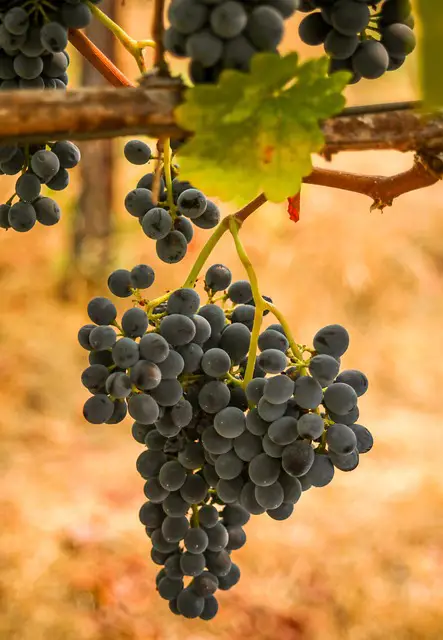When it comes to a battle of the grapes, few rivalries captivate wine enthusiasts quite like Sangiovese and Pinot Noir. These two world-renowned varieties have earned their place in the hearts of wine lovers around the globe. With their enticing flavors and distinctive characteristics, Sangiovese and Pinot Noir often find themselves at the center of heated debates as to which reigns supreme. In this article, we’ll unravel the similarities and differences between these two grape varietals, allowing you to navigate their flavorful rivalry with confidence and knowledge. So, grab a glass and join us on this delightful voyage of discovery into the intriguing world of Sangiovese and Pinot Noir.
Obsah
- Is Sangiovese Similar to Pinot Noir?
- An Exploration of the Flavors and Characteristics
- Comparing the Origins and Terroirs of Sangiovese and Pinot Noir
- Tasting Notes: The Distinctive Profiles of Sangiovese and Pinot Noir
- Food Pairing Recommendations: Enhancing the Best of Sangiovese and Pinot Noir
- Unlocking the Secrets: Key Factors Influencing the Styles of Sangiovese and Pinot Noir
- A Guide to Choosing Between Sangiovese and Pinot Noir: Understanding Personal Preferences and Occasions
- Concluding Remarks
Is Sangiovese Similar to Pinot Noir?
Sangiovese and Pinot Noir:
While both Sangiovese and Pinot Noir are popular red wine varietals, they differ significantly in taste, terroir, and regional origins. Understanding the characteristics of each grape can help you appreciate their unique qualities and find your preference.
Sangiovese:
- Originates from Italy, particularly Tuscany, where it is the main grape in famous wines like Chianti and Brunello di Montalcino.
- Known for its vibrant acidity, medium body, and diverse flavor profiles ranging from cherry and red plum to earthy and spicy notes.
- Often aged in oak barrels to enhance its structure and complex aromas.
- Sangiovese pairs wonderfully with Italian cuisine, such as pasta with tomato-based sauces or grilled meats.
Pinot Noir:
- Hails from France, specifically Burgundy, but is now grown in various regions around the world.
- Renowned for its delicate and elegant nature, featuring red fruit flavors like raspberry, strawberry, and cherry, often accompanied by subtle herbal or floral undertones.
- Usually produced with minimal intervention, allowing the terroir to express itself fully.
- Pinot Noir is a versatile wine that can accompany a range of dishes, including poultry, salmon, and mushroom-based dishes.
While Sangiovese and Pinot Noir share some similarities as red varietals, their distinct characteristics make them exceptional choices for different occasions and palates. Whether you prefer the vibrant and food-friendly Sangiovese or the seductive elegance of Pinot Noir, exploring these wines is an exciting journey for any wine enthusiast.
An Exploration of the Flavors and Characteristics
When it comes to food, flavors and characteristics play a vital role in our overall dining experience. Each ingredient, spice, or technique used in the culinary world brings a unique flavor profile and set of characteristics to the table. From sweet and tangy to rich and savory, the possibilities are endless, making exploration a delightful journey for our taste buds.
One of the most fascinating aspects of flavors is their ability to evoke emotions and memories. The tanginess of a lemon can transport us to a sunny citrus orchard, while the spiciness of chili peppers might remind us of vibrant street markets. Moreover, flavors can vary in intensity, from subtle hints to bold and intense bursts that awaken our senses. Whether it’s the delicate floral notes of a tropical fruit or the earthy undertones of roasted coffee, understanding these characteristics allows us to appreciate the complexity and artistry behind the meals we enjoy.
Exploring Flavors: Key Characteristics
- Intensity: Flavors can range from mild to strong, impacting the overall taste experience.
- Aroma: The scents emitted by ingredients can greatly affect how we perceive flavors.
- Texture: The mouthfeel and consistency of a dish contribute to its overall character.
- Balance: Combining flavors in a harmonious way creates a well-rounded and enjoyable dish.
- Complexity: The depth and layers of flavors can make a culinary creation truly remarkable.
- Contrast: The interplay of contrasting flavors adds intrigue and excitement to a dish.
In the world of gastronomy, an exploration of flavors and characteristics allows us to expand our culinary horizons. It empowers us to appreciate the diversity of tastes, recognize the nuances that differentiate each dish, and savour every bite with a newfound understanding.
Comparing the Origins and Terroirs of Sangiovese and Pinot Noir
Sangiovese and Pinot Noir are two prominent grape varieties that have captivated wine enthusiasts around the world. Both of these red grape varieties have distinct origins and terroirs, contributing to their unique characteristics and flavors. Let’s dive into the fascinating details of these iconic grapes.
Sangiovese:
- Origins in Italy: Sangiovese is an ancient grape variety that finds its roots in Italy, primarily in the region of Tuscany. Its history dates back centuries, and it remains one of the most widely planted grapes in the country.
- Terroir influence: This grape thrives in a warm and dry climate, with the Tuscan sun providing ideal conditions for its growth. The well-drained soil in Tuscany, rich in limestone and clay, imparts unique mineral flavors to the wines.
- Distinctive traits: Sangiovese wines are renowned for their vibrant acidity, medium to full body, and flavors of cherry, plum, and herbs. These characteristics make Sangiovese an excellent pairing for various Italian dishes.
Pinot Noir:
- Origins in France: The Pinot Noir grape hails from the Burgundy region of France. It is considered one of the oldest grape varieties and has spread its influence across the globe.
- Terroir influence: Pinot Noir thrives in cooler climates and is highly sensitive to its surroundings. The terroir, including factors like soil composition and altitude, greatly impacts the grapes’ development and ultimately the character of the wine.
- Distinctive traits: Pinot Noir is known for its delicate and elegant nature, featuring a lighter body, moderate tannins, and flavors of red berries, cherry, and earthiness. Its versatility allows it to pair well with a wide range of dishes.
While both Sangiovese and Pinot Noir have their own unique charm and taste profile, exploring their origins and terroirs allows us to appreciate the immense diversity in the world of wine. Whether you prefer the boldness of Sangiovese or the finesse of Pinot Noir, these grapes continue to captivate wine lovers with their distinct qualities and ability to express the essence of their respective regions.
Tasting Notes: The Distinctive Profiles of Sangiovese and Pinot Noir
When it comes to the world of wine, few varietals possess as much character and uniqueness as Sangiovese and Pinot Noir. Both these red wines bring a rich tapestry of flavors and aromas that captivate the senses. Let’s dive into the distinctive profiles of these two remarkable grapes:
Sangiovese:
- Color: Sangiovese typically displays a brilliant ruby red hue, sometimes with a slight garnet tinge.
- Aroma: The nose is greeted by a symphony of red fruit notes, such as cherry, raspberry, and strawberry, underscored by subtle herbal and earthy nuances.
- Palate: On the palate, Sangiovese reveals a medium body with moderate acidity and silky tannins that create a balanced and elegant structure. Its vibrant fruit flavors intermingle with hints of spice, dried herbs, and a touch of leather, creating a harmonious and lengthy finish.
Pinot Noir:
- Color: Pinot Noir delights the eye with a beautiful, translucent garnet color that often leans towards a lighter shade.
- Aroma: Its aromatic bouquet is enchanting, offering a range of red fruits like cherry, cranberry, and red currant, complemented by delicate floral notes of rose and violet.
- Palate: Pinot Noir is known for its light to medium body, with silky tannins that caress the tongue. The wine dances on the palate with red fruit flavors balanced by a touch of earthiness and a whisper of oak. It finishes with a delightful acidity that adds freshness and great finesse.
Whether you find yourself enjoying a glass of Sangiovese or Pinot Noir, each sip tells a story of the terroir, the winemaking skills, and the rich history behind these delightful wines. Indulge in the distinctive profiles of these two remarkable varietals, and let your taste buds embark on a captivating journey.
Food Pairing Recommendations: Enhancing the Best of Sangiovese and Pinot Noir
When it comes to indulging in a glass of red wine, Sangiovese and Pinot Noir are two varietals that never disappoint. Both packed with distinctive flavors and aromas, they offer a wealth of possibilities when paired with the right dishes. To help you elevate your tasting experience, we present some mouthwatering food pairing recommendations that perfectly complement the best of Sangiovese and Pinot Noir.
For the Sangiovese enthusiasts, this Italian gem is known for its medium to full body and vibrant acidity. Its cherry, tobacco, and herbal notes call for dishes with robust flavors. For a delightful match, consider pairing Sangiovese with:
- Hearty Pastas: Sangiovese’s high acidity cuts through the richness of pasta dishes and complements tomato-based sauces like Bolognese or arrabbiata.
- Grilled Meats: The fruity and earthy flavors of Sangiovese pair beautifully with grilled meats, especially those with a hint of smokiness, like a juicy steak or lamb chops.
- Hard Cheeses: The sharpness and complexity of aged cheeses like Parmigiano Reggiano or Pecorino Romano provide a delightful contrast to the wine’s fruity characteristics.
When it comes to Pinot Noir, this elegant wine boasts delicate flavors of red berries, earthy undertones, and a silky texture. Its versatility allows for a wide range of food pairings. To unlock the intricate flavors of Pinot Noir, try these delectable combinations:
- Salmon or Tuna: The silky texture and bright acidity of Pinot Noir perfectly complement the richness of grilled or poached salmon, or even a fresh tuna steak.
- Mushroom Dishes: The earthy and umami flavors found in mushrooms create a harmonious pairing with Pinot Noir, whether it is a mushroom risotto, truffle-infused pasta, or a creamy mushroom soup.
- Roasted Duck: The succulent and savory qualities of roasted duck beautifully mesh with the fruity and delicate flavors of Pinot Noir, resulting in a match made in culinary heaven.
Unlocking the Secrets: Key Factors Influencing the Styles of Sangiovese and Pinot Noir
When it comes to wine, two grape varieties have captured the hearts of connoisseurs worldwide: Sangiovese and Pinot Noir. These illustrious red grapes have distinctive styles that are influenced by several key factors. Understanding these factors can not only enhance your appreciation for these wines but also help you pair them perfectly with your favorite dishes. Here are the key factors that unlock the secrets behind the styles of Sangiovese and Pinot Noir:
Mother Nature’s Influence:
- Climate: The climate in which these grapes are grown plays a fundamental role in their style. Sangiovese thrives in hotter climates, resulting in wines that are richer, fruit-forward, and high in alcohol. On the other hand, Pinot Noir prefers cooler climate conditions, which impart delicate and elegant flavors to the wine.
- Terroir: Soil composition and geographical location significantly impact the flavor profile of these wines. Sangiovese’s character is significantly shaped by the clay and limestone soils found in Tuscany, leading to earthy undertones and structured tannins. Conversely, Pinot Noir vines flourish in chalky terrain, lending itself to more subtle and complex flavors.
- Ancient Vines: The age of the vines contributes to the depth and complexity of both Sangiovese and Pinot Noir wines. Older, well-established vines yield lower grape yields, resulting in more concentrated flavors and refined tannins.
The Winemaker’s Art:
- Vinification Techniques: The choice of fermentation process and aging methods can dramatically alter the style of these wines. Sangiovese’s traditional maceration and extended oak aging give rise to bolder, fuller-bodied expressions. Meanwhile, Pinot Noir often undergoes a more delicate fermentation process to preserve its delicate fruit flavors and is typically aged in French oak barrels for a subtle influence.
- Blending: Sangiovese can be blended with other grape varieties, such as Canaiolo or Merlot, to soften its tannins and enhance its fruity characteristics. Pinot Noir, however, is often celebrated as a single varietal wine to showcase its unique expression and elegance.
- Traditions versus Innovations: The winemaker’s philosophy and commitment to traditional or innovative techniques also play a significant role in shaping the style of Sangiovese and Pinot Noir. From meticulous vineyard management practices to modern cellar technologies, each approach adds its touch to the final result.
Unlocking the secrets behind the styles of Sangiovese and Pinot Noir begins with a deeper understanding of the intricate factors that influence these wines. Climate, terroir, vine age, vinification techniques, blending options, and winemaking philosophy all work together to create unique expressions that captivate wine enthusiasts around the globe. By exploring the vast world of possibilities within these two remarkable grape varieties, you can embark on a fascinating journey that reveals the beauty and diversity of wine.
A Guide to Choosing Between Sangiovese and Pinot Noir: Understanding Personal Preferences and Occasions
When it comes to selecting the perfect wine, understanding personal preferences and occasions can greatly enhance your enjoyment. Two popular choices, Sangiovese and Pinot Noir, offer distinct flavors and characteristics that cater to different palates and pairings.
Understanding Sangiovese:
Sangiovese, originating from Italy, boasts a robust and earthy profile that appeals to many wine enthusiasts. Its medium to full body showcases flavors of red cherries, plum, and a subtle hint of spice. This versatile wine is excellent when paired with rich Italian dishes such as tomato-based pasta, roasted meats, or aged cheeses. If you appreciate a wine with a harmonious balance of acidity and tannins, Sangiovese might just be your perfect match.
Exploring Pinot Noir:
On the other hand, Pinot Noir offers a more delicate and nuanced experience. Known for its light to medium body, this wine showcases flavors of red berries, floral notes, and a touch of earthiness. The elegant and complex nature of Pinot Noir makes it a splendid option for various occasions. Opt for a bottle of Pinot Noir when you’re hosting a special dinner, enjoying a romantic evening, or simply looking to unwind after a long day. Its versatility and soft tannins make it a great companion for dishes like salmon, roasted poultry, or mushroom-based entrees.
Whether you lean towards the bold and lively character of Sangiovese or the elegant charm of Pinot Noir, both wines offer a delightful journey for your taste buds. Remember, personal preferences and the occasion play crucial roles in selecting the perfect bottle. So, take your time, explore different options, and savor the pleasurable experience that comes with each sip.
Concluding Remarks
In conclusion, Sangiovese and Pinot Noir may share some similarities in flavor profiles, but their distinct characteristics set them apart. Both wines offer unique experiences that can enhance any wine enthusiast’s palate.







